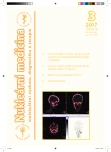Comparison of staff irradiation after replacing 131I solution with capsules
Authors:
Lenka Jonášová; Tereza Kráčmerová; Pavel Solný
Authors‘ workplace:
Klinika nukleární medicíny a endokrinologie 2. LF UK a FN Motol, Praha 5, ČR
Published in:
NuklMed 2017;6:49-52
Category:
Original Article
Overview
The treatment of the thyroid cancer with 131I radioiodine is a medical method proven during tens of years. This method is prone to risk of external as well as internal irradiation for the staff of any department. The risk is from a direct contact with a radiopharmaceutical (Na131I), with an injected patient or with a waste. External and also internal irradiation can occur during routine work. The staff of radio pharmacy is placed at risk of direct contact because the radiopharmaceutical is prepared and the radioactive waste is processed here.
Comparison of radiation burden of the staff during the change of medical form (from solution to capsules of 131I) was done based on the assessment of whole body and finger dosimeters and values acquired from the measurement of internal contamination of the thyroid gland. We chose a time interval from September 2012 to the end of August 2016 (9/2012 – 8/2014 solution of 131I and 9/2014 – 8/2016 capsules with 131I). The dosimetric results were also assessed in relation to injected radioactivity in these periods.
Four radiographers and one radiological technician working in the Department of Nuclear Medicine and Endocrinology of the University hospital Motol were chosen to assess radiation burden. Contamination of the thyroid gland and also dose equivalent decreased in order of tens percents in these staffers after a shift of medical form to capsules. There was no significant change of radiation burden in other staff of the 2nd ward of the department.
Key Words:
131I, radioiodine, personnel dosimetry, internal contamination, thyroid gland, radiation protection
Sources
1. Schuerer M, Buchali K, Correns HJ et al. Radiation protection aspects using 131I sodium iodine capsules for radioiodine therapy, Nuc Compact, Compact News in Nuclear Medicine. [online]. 1981;12:148-152 [cit. 2017-03-29]. Dostupné na: https://inis.iaea.org/search/search.aspx?orig_q=RN:13680264
2. Khalil MM, Basic Sciences of Nuclear Medicine (Radioiodine therapy:Safety consideration), Berlin Heidelberg, Springer Science & Business Media, 2010,423 p
3. Meloun M, Militký J: Statistické zpracování dat, Praha, Edice Plus, 1994, 839 p
4. Shier R, Statistics: General leaflets (e-book), kap. The Mann Whitney U test, Loughborough University [online] 2004.[cit. 2017-03-29] Dostupné na: http://www.statstutor.ac.uk/resources/uploaded/mannwhitney.pdf
5. Krajewska G, Pachocki KA, Assessment of exposure of workers to ionizing radiation from radioiodine and technetium in nuclear medicine departmental facilities, Med Pr 2013;64(5):625–630 [cit. 2017-04-03] Dostupné na: http://medpr.imp.lodz.pl/Ocena-narazenia-pracownikow-na-promieniowanie-jonizujace-radiojodu-i-technetu-w-zakladach-medycyny-nuklearnej,497,0,2.html
6. Leide-Svegborn S, External radiation exposure of personnel in nuclear medecine from 18F, 99mTc and 131I with special reference to fingers, eyes and thyroid, Radiation Protection Dosimetry [online] 2012;149:196–206 [cit. 2017-03-29] Dostupné na: https://academic.oup.com/rpd/search-results?page=1&q=EXTERNAL%20RADIATION%20EXPOSURE%20OF%20PERSONNEL%20IN%20NUCLEAR%20MEDICINE%20FROM%2018F%2C%2099mTC%20AND%20131I%20WITH%20SPECIAL%20REFERENCE%20TO%20FINGERS%2C%20EYES%20AND%20THYROID&SearchSourceType=1
Labels
Nuclear medicine Radiodiagnostics RadiotherapyArticle was published in
Nuclear Medicine

2017 Issue 3
Most read in this issue
- Direct quantification of the growing activity of the mandible condyle in unilateral idiopathic condylar hyperplasia
- Radiation protection of PET/CT staff
- Comparison of staff irradiation after replacing 131I solution with capsules
